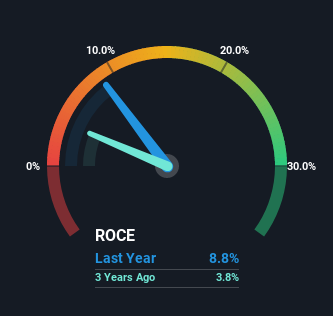- United States
- /
- Transportation
- /
- OTCPK:YELL.Q
Yellow (NASDAQ:YELL) Has More To Do To Multiply In Value Going Forward
If you're looking for a multi-bagger, there's a few things to keep an eye out for. Firstly, we'll want to see a proven return on capital employed (ROCE) that is increasing, and secondly, an expanding base of capital employed. This shows us that it's a compounding machine, able to continually reinvest its earnings back into the business and generate higher returns. In light of that, when we looked at Yellow (NASDAQ:YELL) and its ROCE trend, we weren't exactly thrilled.
What Is Return On Capital Employed (ROCE)?
Just to clarify if you're unsure, ROCE is a metric for evaluating how much pre-tax income (in percentage terms) a company earns on the capital invested in its business. The formula for this calculation on Yellow is:
Return on Capital Employed = Earnings Before Interest and Tax (EBIT) ÷ (Total Assets - Current Liabilities)
0.088 = US$143m ÷ (US$2.5b - US$892m) (Based on the trailing twelve months to June 2022).
So, Yellow has an ROCE of 8.8%. In absolute terms, that's a low return and it also under-performs the Transportation industry average of 15%.
Check out our latest analysis for Yellow

In the above chart we have measured Yellow's prior ROCE against its prior performance, but the future is arguably more important. If you'd like, you can check out the forecasts from the analysts covering Yellow here for free.
What The Trend Of ROCE Can Tell Us
There are better returns on capital out there than what we're seeing at Yellow. The company has consistently earned 8.8% for the last five years, and the capital employed within the business has risen 35% in that time. Given the company has increased the amount of capital employed, it appears the investments that have been made simply don't provide a high return on capital.
The Bottom Line On Yellow's ROCE
Long story short, while Yellow has been reinvesting its capital, the returns that it's generating haven't increased. Since the stock has declined 59% over the last five years, investors may not be too optimistic on this trend improving either. In any case, the stock doesn't have these traits of a multi-bagger discussed above, so if that's what you're looking for, we think you'd have more luck elsewhere.
One more thing: We've identified 3 warning signs with Yellow (at least 2 which are a bit unpleasant) , and understanding them would certainly be useful.
While Yellow may not currently earn the highest returns, we've compiled a list of companies that currently earn more than 25% return on equity. Check out this free list here.
New: Manage All Your Stock Portfolios in One Place
We've created the ultimate portfolio companion for stock investors, and it's free.
• Connect an unlimited number of Portfolios and see your total in one currency
• Be alerted to new Warning Signs or Risks via email or mobile
• Track the Fair Value of your stocks
Have feedback on this article? Concerned about the content? Get in touch with us directly. Alternatively, email editorial-team (at) simplywallst.com.
This article by Simply Wall St is general in nature. We provide commentary based on historical data and analyst forecasts only using an unbiased methodology and our articles are not intended to be financial advice. It does not constitute a recommendation to buy or sell any stock, and does not take account of your objectives, or your financial situation. We aim to bring you long-term focused analysis driven by fundamental data. Note that our analysis may not factor in the latest price-sensitive company announcements or qualitative material. Simply Wall St has no position in any stocks mentioned.
About OTCPK:YELL.Q
Low risk with weak fundamentals.
Similar Companies
Market Insights
Community Narratives





